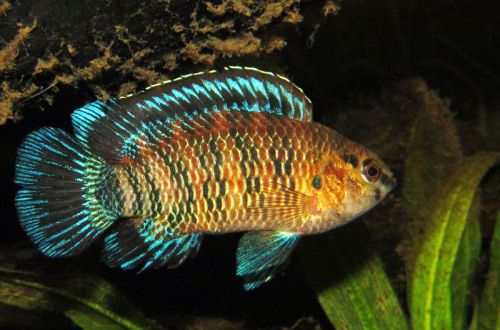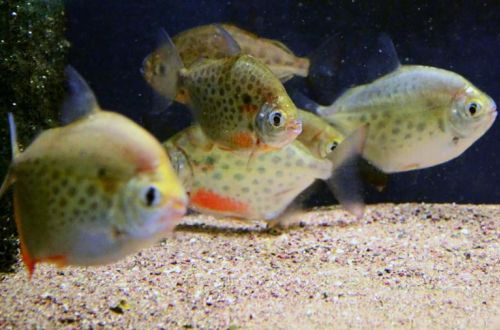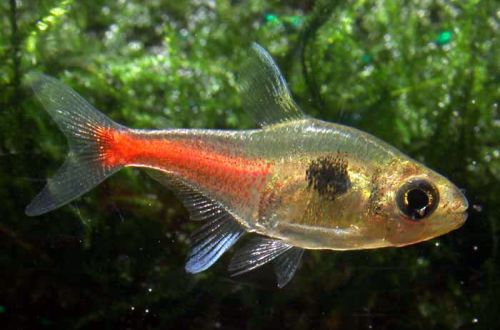
chameleon nga isda
Badis, Badis Chameleon or Chameleon Fish, scientific name Badis badis, belongs to the Badidae family. This species got its name due to the ability to change color over time depending on the environment. They are considered easy to keep and rather unpretentious fish, they can be recommended to beginner aquarists.

Kaundan
Habitat
It comes from Southeast Asia from the territory of modern India, Pakistan, Nepal, Bangladesh, Myanmar and Thailand. It lives in shallow, rather muddy sections of rivers with a slow flow and abundant vegetation. The bottom is usually viscous, silty and littered with numerous branches, foliage, and other woody debris.
Mubo nga impormasyon:
- Ang gidaghanon sa aquarium - gikan sa 50 ka litro.
- Temperatura – 20-24°C
- Bili pH - 6.0-7.5
- Katig-a sa tubig – humok ngadto sa kasarangang gahi (3-15 dGH)
- Type sa substrate - balas ug graba
- Pagsiga – ubos / kasarangan
- Brackish nga tubig - dili
- Ang paglihok sa tubig - gamay o wala
- Ang gidak-on sa isda hangtod sa 5 cm.
- Pagkaon - bisan unsang pagkaon
- Temperament - kondisyon nga malinawon
- Pagpabilin nga nag-inusara o nagtinagurha nga lalaki / babaye
Description
Adults reach a length of up to 6 cm. The color is variable and depends on the environment, it can vary from orange to blue or purple. A similar feature is reflected in the name of the fish – “Chameleon”. Males are somewhat larger than females and are more brightly colored, especially during the mating season.
Food
They belong to carnivorous species, but the breeders managed to accustom Badis to dry food, so there will be no problems with feeding in a home aquarium. It is recommended to include in the diet live or frozen meat products (bloodworm, daphnia, brine shrimp), which contribute to the development of a better color.
Pagmentinar ug pag-atiman, kahikayan sa aquarium
The size of the aquarium for one or a pair of fish starts from 50 liters. The design uses a sand and gravel substrate, shade-loving rooting and clusters of floating plants, as well as shelters in the form of branches and roots of trees, various snags. As future spawning grounds, you can use decorative objects that form grottoes, caves, or simple ceramic pots turned over on their side.
Optimal housing conditions are achieved with low to medium light levels and low internal flow. The water temperature should be no higher than 23-24°C. The equipment is adjusted based on these conditions; in some cases, you can do without a heater. The hydrochemical parameters pH and dGH have wide acceptable values and are not so critical.
Ang pagmentinar sa aquarium moabut ngadto sa regular nga paglimpyo sa yuta gikan sa organikong basura, kada semana nga pag-ilis sa bahin sa tubig (10-15% sa gidaghanon) sa presko nga tubig.
Kinaiya ug Pagkaangay
Calm and slow fish, so you should avoid sharing with active and / or large species that can intimidate Badis. But miniature cyprinids such as Rasbora Harlequin, Rasbora Espes and the like, as well as small flocks of characins, can become excellent neighbors.
Intraspecific relationships are built on the dominance of the alpha male in a particular area. In a small aquarium, it is worth keeping only one male paired with a female. If there are several males, they can arrange fierce fights among themselves.
Pagpasanay / pagpasanay
The appearance of fry is quite possible in the general aquarium, the badis-chameleon has well-developed parental instincts, like other labyrinth fish, therefore it will take care and protect future offspring.
Spawning takes place in shelters similar to caves, under the arch of which the eggs are located. Tiled on its side ceramic pots are perfect for this role. With the beginning of the mating season, the male acquires a more saturated dark color, the behavior becomes quite warlike if someone violates the boundaries of his territory, the center of which is the spawning ground. The male attempts to literally drag the female into his shelter, if she is ready, then she succumbs to his requirements.
When the eggs are laid, the female leaves the cave, and the male remains to guard the clutch and fry until they swim freely. Not it takes from one to one and a half weeks. Then the male loses interest in them and it is advisable to move the juveniles to a separate tank with identical conditions.
Mga sakit sa isda
Ang panguna nga hinungdan sa kadaghanan sa mga sakit mao ang dili angay nga kahimtang sa pagpuyo ug dili maayo nga kalidad nga pagkaon. Kung ang una nga mga simtomas nakit-an, kinahanglan nimo nga susihon ang mga parameter sa tubig ug ang presensya sa taas nga konsentrasyon sa mga peligro nga mga sangkap (ammonia, nitrite, nitrates, ug uban pa), kung kinahanglan, ibalik ang mga timailhan sa normal ug pagkahuman ipadayon ang pagtambal. Basaha ang dugang bahin sa mga sintomas ug pagtambal sa seksyon sa Mga Sakit sa Isda sa Aquarium.





